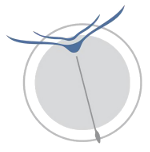Understanding lifetime tracks and fitness of long-distance avian migrants
Movement is the very essence of life, but we do not yet understand how organisms move during their lifetime and how movement affects the survival and fitness of an individual. The emerging field of ”Movement Ecology”, established largely by the PI and his collaborators, addresses these questions at a time when new technologies finally promising a golden era of exciting discoveries on a global scale.
We propose to study one exemplary species of vertebrate, the White Stork, and to determine the lifetime tracks of hundreds of individuals from six breeding populations across Europe and the Middle East. We will use the newly developed ‘blackbox’ bio-logging technology that allows us to determine exact position via GPS as well as behavior via 3D-acceleration sensors throughout the birds’ successive inter-continental migratory journeys every year. We will also quantify the internal state of the birds via overall dynamic body acceleration (ODBA), and link that to external variables in the environment such as wind, temperature, NDVI and rainfall.
Analyzing the internal and external state of an individual in relation to its apparent movement decisions will allow us to determine its lifetime use of energy as a function of the environmental variables. In turn, we will finally understand survival and fitness of a model organism in the wild on a mechanistic level as the consequence of subsequent individual decisions in space and time. Individual decisions will include the use of atmospheric assistance, stop-over and foraging decisions, risk taking, mate choice, habitat choice and seasonal use of migratory corridors. New modeling approaches will then enable us to combine the lifetime tracks and decisions of hundreds of individuals into a global picture of changes in the environment that every individual experienced during its lifetime.
We will also be able to determine the effects that climate and habitat change will exert on populations of large vertebrates in space and time. Our results will have profound consequences for the entire field of biology which is currently in dire need to understand where, when and how selection pressures shape the design of organisms. The research will be carried out by four groups, two in Israel (Hebrew University of Jerusalem and the Technion) and two in Germany (Max-Planck Institute for Ornithology, Konstanz University, Potsdam University) covering a broad range of complementary, relevant expertise. We expect that this well-balanced combination will promote a synergistic collaboration and yield new insight into the factors affecting survival and fitness of organisms, an unresolved topic at the very center of biology and environmental sciences.
Status:
Currently In Progress



